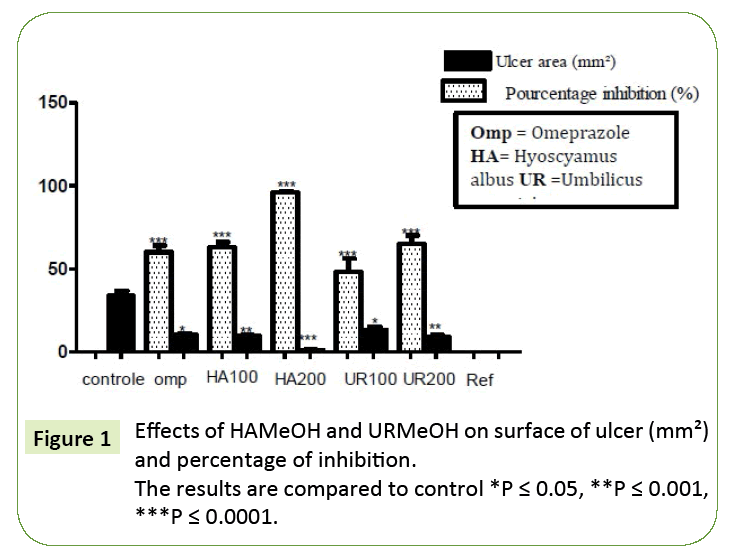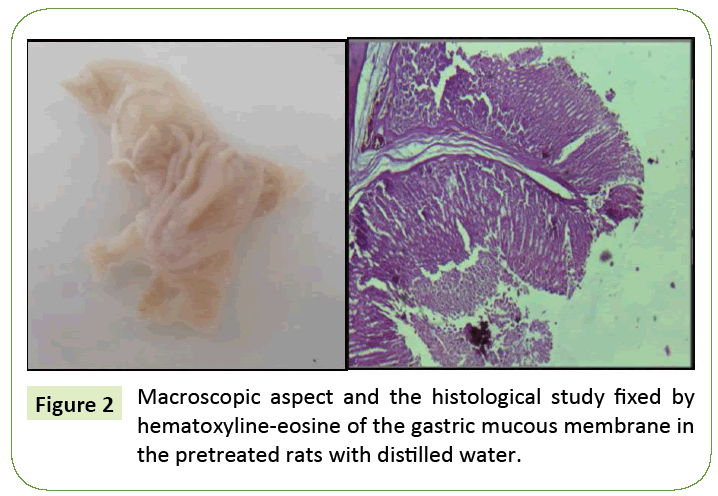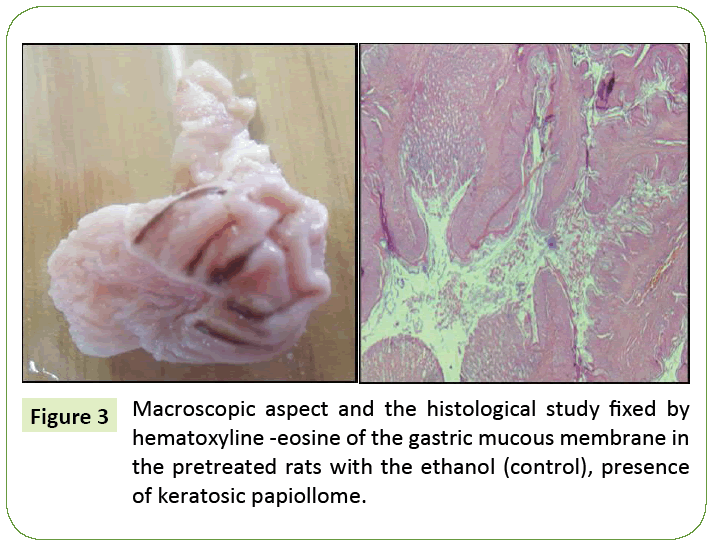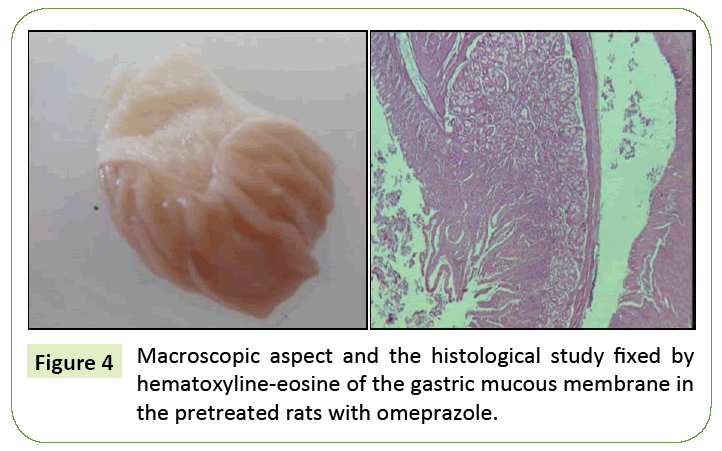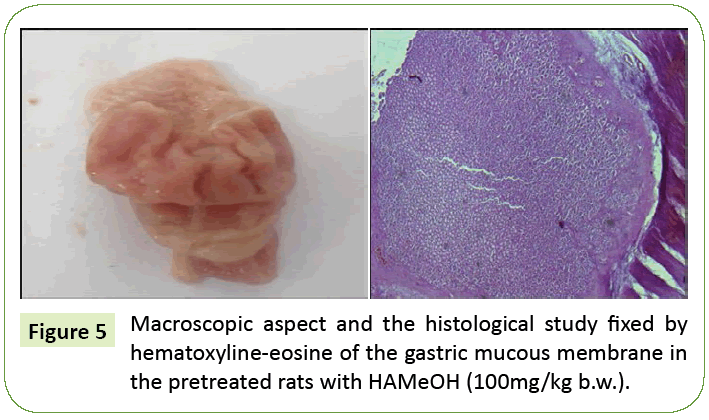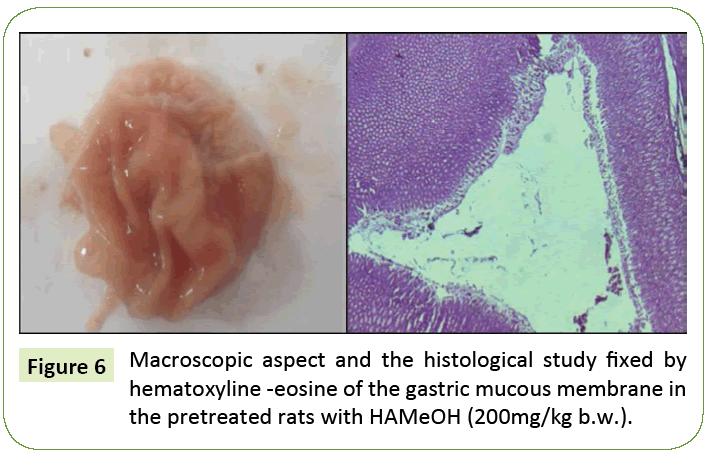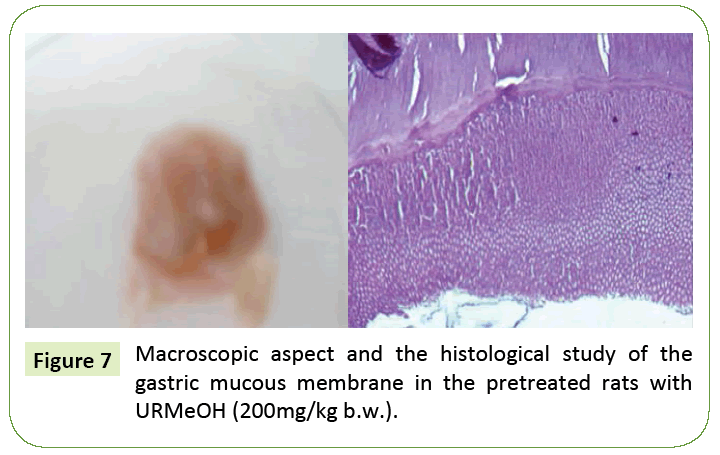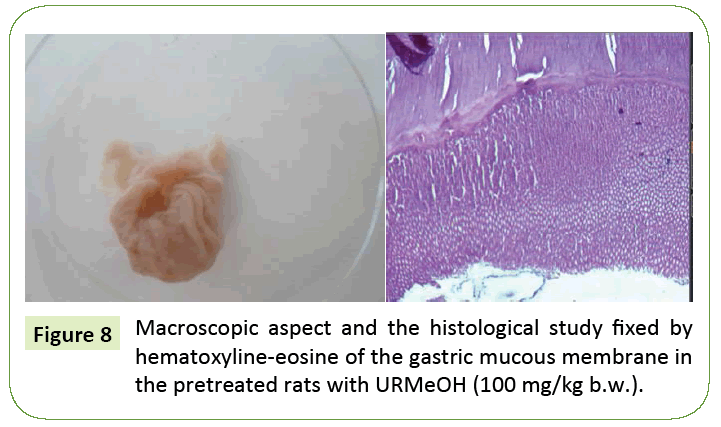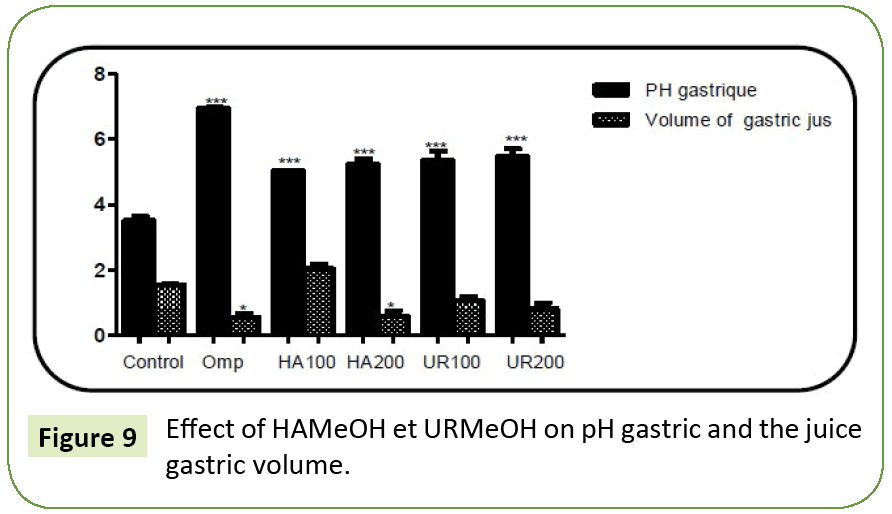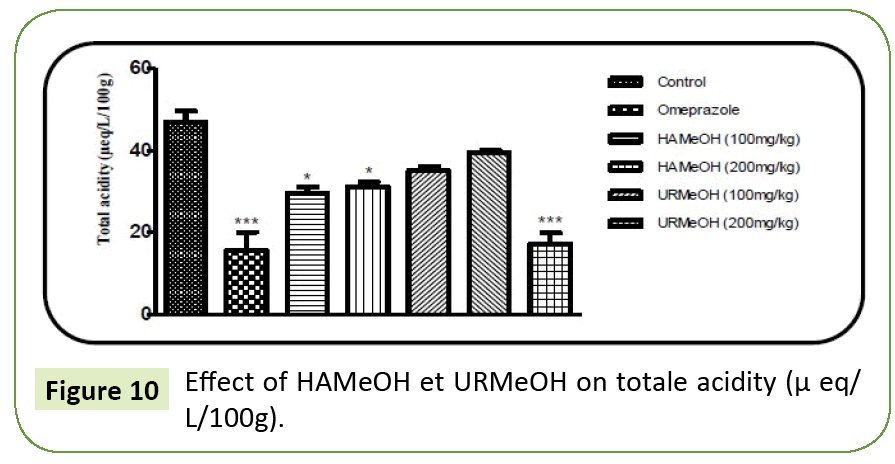ISSN : 2393-8854
Global Journal of Research and Review
Ulcer Healing and Gastroprotective Activity of Methanolic Extracts of Hyoscyamus Albus and Umbilicus Rupestris Leaves against Gastric Injury Caused by Ethanol in Rats
Massinissa Yahia1*, Mouloud Yahia1, Afaf Benhouda1, Souhila Benbia1, and Hachani Khadraoui2
1University in Naples, Federico II, pharmacy via Leonard Bianchi, Italy
2Loboratory of Anapathology CHU of BATNA, Algeria
- *Corresponding Author:
- Massinissa Yahia, PhD
University in Naples, Federico II
pharmacy Via leonarod Bianchi
Naples, Italy
Tel: 3311236528
Fax: 3311236528
E-mail: masipsa@hotmail.com
Received date: February 22, 2017; Accepyed date: February 27, 2017; Published date: March 07, 2017
Citation: Yahia M, Yahia M, Benhouda A, et al. Ulcer Healing and Gastroprotective Activity of Methanolic Extracts of Hyoscyamus albus and Umbilicus rupestris Leaves against Gastric Injury Caused by Ethanol in Rats. Glob J Res Rev. 2017, 4:1.
Abstract
The present study was performed to evaluate the anti-ulcer activity of methanolic extract of Hyoscyamus albus and Umbilicus rupestris against ethanol-induced gastric ulcer. Experimental groups were orally pre-treated with and 100, and 200 mg/kg b.w of methanolic extracts HAMeOH and URMeOH. Ulcer control group were pre-treated just with absolute ethanol and reference group was orally pretreated with omeprazole (20 mg/kg b.w). After one hour of pretreatment, all rats were received the absolute ethanol to generate gastric mucosal injury. And after one hour, our rats were anesthetized and sacrificed and the ulcer areas of the gastric walls were determined. Grossing evaluation has revealed that the negative control rats exhibited severe mucosal injury, whereas, pre-treatment with U. rupestris leaf extract and H. albus has resulted significantly anti gastric mucosal injury and flattening of the mucosal folds. Histological studies of the gastric wall that the pre-treated with URMeOH and HAMeOH leaf extract was pronounced as gastric protection along followed by reduction or inhibition of leucocytes in the infiltration of the submucosa.
Keywords
Antiulcer activity; Hyoscyamus albus; Umbilicus rupestris; Ethanol; Methanolic extract
Introduction
Umbilicus rupestris (Salisb.) Dandy is a perennial plant, belongs to the family of Crassulaceae. It presents on the rocks, the old walls and in mountains; only in North Africa. Leaves of this plant are used in traditional medicine against the ignitions of skin, wounds, burns, disinfectant, parasiticidal. Infused (leaves) of this plant is used like an ophthalmic disinfectant [1]. H. albus is a plant which belongs for Solanaceae family, it used in traditional medicine as a nervous sedative and para sympatholytic [2]. Natural products are very important in pharmaceutical industry and also in search of new potential sources of bioactive molecules [3].
Omeprazole is drug highly selective for the proton pump and catalyzed conversion into active form within the acid forming space [4]. We used in our study; omeprazole was used as the reference anti-ulcer drug.
The ulcer can cause by a lot of caused non stroidiens inflammatory, stress or alcohol. They researchers found that ethanol is the simple method that the method of absolute ethanol is the most simple used to induce gastric ulcer. Ethanol induces the liberation of free radical species and Nordmann [5].
Therefore, the present study was to evaluate the antiulcerogenic property of the methanolic extract of Hyoscyamus albus and Umbilicus rupestris against ethanol-induced gastric mucosal injury in experimental rats.
Materials and Methods
Collection of the plant
The leaves of Hyoscyamus albus nd Umbilicus rupestris were harvested in March 2015 from the Wilaya of Batna region Tibhirine Algeria. Botanical species identification was realised by Dr. B. OUDJHIH, Botanical Laboratory, Department of agronomy, University of EL-Hadj Lakhdar – Batna. 40 days in a dry and aerial place for the extraction of active compounds
Extraction by organic solvents
1 Kg of powdered leaves was extracted with 5 L of petroleum ether for three times. Then, the marc was dried and extracted with 5 L of chloroform for three times and with 5 L of methanol for three times and the supernatants were filtered separately using cotton and Whatman filter paper. The solvents were then evaporated under reduced pressure (204 mbar) and controlled temperature (30°C) using a vacuum rotary evaporator (Buchi Rotavapor).
Phytochemical screening
The phytochemical screening of HAMeOH and URMeOH was realised by using the method of 8 Phytochemical constituents which is: phenolic compounds, terpenoids, saponins, alkaloids, steroids and tannins were analysed qualitatively.
Animals
Wistar rats weighted (140-170 g) provided by the Pasteur Institute – Algiers. These rats were allowed at favorable conditions before and during the experiment: Temperature (23 ± 2)°C, relative humidity 50-55% with 12 h light/12 h night cycle respectively. The food and water were given ad libitum.
Evaluation of Antiulcer activity
The study of this activity, we have uses the method of Garg et al. The rats males was divided into six groups of six rats. These rates were deprived 48 h before the experiment but with accesses of water two hours before the experiment and received by gavage the following treatments: Group I: received distilled water with (5 mL/kg p c) and is useful like a witness, Group II: received distilled water (5 mL/kg b.w.) and served as a control, Groups III and IV: received HAMeOH with the two concentrations (100 and 200 mg/Kg b.w.) respectively, Groups V and VI: received URMeOH (100 and 200 mg/Kg b.w.) respectively with a volume of (10 ml/Kg PC), Group VII: received the omeprazole (20 mg/kg PC) (5 mL/kg b.w.) as standard. 30 min after pretraitement, the ulcer was induced by oral administration of absolute ethanol (5 mL/ kg b.w.) except control group. The rats were dessicated 60 min after ethanol administration and each stomach was open along the great curve, and were washed with water physiological [6].
Evaluation of the gastric lesions
Ulcers found in the gastric mucous membrane appearing in the form of bands ellongate of hemorragic lesions parallel to the long axis of the stomach. Surface d’ulcere gastric was calculated according to the method of Kauffman and Grossman with some modification [7]. The length (mm) and the width (mm) of the ulcer on the mucous membrane gastric were measured by the method of squaring under a binocular magnifying glass (of x1.8). The surface of each lesion of ulcer was measured by counting the number of small squares, 1 X 1 mm, covering the length and the width of each band of the ulcer. The sum of surfaces of all the lesions for each stomach was applied for calculation surface of ulcer (UA) when the sum of small squares is multiplied with magnification 1,8.
Measure of gastric volume of juice
The gastric volume of juice has ete measurement has l’aide d’une syringe.
Percentage inhibition
The inhibition percentage of the ulcers was determined according to the formulate below: [8,9].
Inhibition (%)=[(UA controls UA traited)/UA control] x 100 UA controls: ulcerous surface of the group controls. Treated
UA: ulcerous surface of the treated group.
Measure of total acidity
1 mL of gastric juice was diluted 10 times with distilled water and subjected a titration has by NaOH has 0.01 NR with adding few drops of phenolphthalein drops until pink color.
Total acidity is calculated according to there following formula.
Total acidity=(volume of NaOH × Normality × 100 mEq/L/100 g)/0.1
Histopathology
Stomach Samples have fixed in phormol 10% for histopathological study with using hematoxyline-eosine.
Results
The HAMeOH extract reduced the surface of ulcer in a significant way (P<0.05) with an inhibition of 63% and 95.90% for (100 and 200 mg/kg b.w.) respectively. Still URMeOH could inhibit in a significant way (P<0.05) the ulcer with an inhibition (48.98% and 65.94%) for the concentrations (100 and 200 mg/kg b.w.) respectively.
The omeprazole which was used like a standard of reference educed in a significant way (P ≤ 0.05) the ulcer with an effect (60.23%) (Figure 1).
In the group controls, of the serious wounds were observed on the level of the gastric mucous membrane. The ethanol produced one necrosis hemorrhagic visible gastric mucous membrane. It caused disturbances of the epithelium of surface and necrotic lesions which penetrated deeply in the mucous membrane and a papilloma keratosis (Figure 2). However, in animals treated with the extracts, the whole of the signs observed at control group were gone in a significant way especially with the extract HAMeOH 200 mg/Kg b.w. (Figures 3-6).
According to results of measurement of the gastric juice volume, we noted that there is a significant reduction (P ≤ 0.05) in the gastric volume of juice in the rats treated by HAMeOH (200 mg/ kg b.w.) and by the omeprazole compared to control and any difference between the rats treated with URMeOH compared to control (Figures 7 and 8). Moreover, we noted that there is a highly significant increase (P<0.0001) in the value of the pH in the rats treated with HAMeOH (100 and 200 mg/kg b.w.) with values of (5.035 ± 0.035) and (5.240 ± 0.240) respectively compared to the control which presents a pH (3.525 ± 0.1768). Still a highly significant increase (P<0.0001) in the values of pH at the groups treated with URMeOH (100, 200 mg/kg b.w.) and the omeprazole compared to control with values of (5.355 ± 0.417), (5.475 ± 0.332) and (6.94 ± 0.332), respectively, was noted (Figure 9).
The results are compared to control *P ≤ 0.05, ** P ≤ 0.001, ***P ≤ 0.0001.
For total acidity, the omeprazole showed a significant reduction (P ≤ 0.05) compared to control. And this reduction was noticed in a significant way (P ≤ 0.05) also at the group treated with HAMeOH 100 mg/Kg and 200 mg/Kg (Figure 10).
The gastrin is the only hormone able to control the secretion of acid per the increase in the mass of the parietal cells and stimulation of the form of the acid pump H+ K+ ATPase. Although the parietal cells express the protein H+ K+ ATPase.
Thus, it appears that the mode of action of the HAMeOH extract is similar to that of the omeprazole, which bind very specifically to only one sub-unit of H+K+ ATPase on the secretary surface of the parietal cell and the inactive one, and it makes it possible to reduce the secretion of acid whatever the source of stimulation of secretion. The omeprazole is effective in the treatment of UGD and the backward flow gastro-oesophagian after its use is with length or short-term [10].
Discussion
Gastroduodenal ulcer (UGD) described a state in which there is a discontinuity in all the thickness of gastric and the mucous membrane which persists because of the acid and pepsin in the gastric juice [11]. The gastroduodenal ulcers are caused by an imbalance between the defensive mechanisms (defensive mucosal barrier, secretion of bicarbonate, PG) and the aggressive mechanisms (acid, pepsin and Helicobacter pylori of the mucous membrane [12,13]. The ethanol produces necrotic lesions by its direct action on the stomach what reduces the factors of defense like secretion of bicarbonate and the production of mucus [12]. The ethanol can reach the mucous membrane by the rupture of the mucus-bicarbonate barrier and the rupture of the cells in the wall of the blood vessels. These effects are probably due to the some biological phenomena’s like the peroxidation of the membranes, the formation of the free radicals, intracellular effort oxidizing, the change of the permeability and depolarization of the mitochondrial membrane before cellular death [14].
Many drugs including the inhibitors of the pump with protons, the prostaglandin analogues, histamine antagonists and the cytoprotective agents are available for the treatment of the gastroduodenal ulcer. But the majority of these drugs produces several adverse effects including toxicity and can even deteriorate the biochemical mechanisms of the body especially after the chronic use [15]. Currently, the natural products are generally used to avoid the chronic use of the drugs. Several natural products were announced like having an anti-ulcer genic activity by their effect of defense of mucous membrane [16].
The anti-ulcer effect of the methanolic extracts of H. albus and U. rupestris is with their wealth’s of secondary metabolites such as: flavonoids, saponins and the tannins which were announced known by their anti-ulcerogenic and anti-gastric activity [17]. Many work reported that the flavonoids and the tannins play a significant role in the reduction of the ulcer and the protection of the gastric cells [18]. The flavonoids are antioxidants and powerful trappers of the free radicals which prevent ulceration and the cellular oxidative lesions. In fact major, the compounds are known by their antiulcer effects by inhibition of the lesions of the gastric mucous membrane [18]. It was also reported that the flavonoïds ensures a protection against gastric cancer [19,20].
According to Havsteen, the antiulcer effect of the flavonoids is due to the inhibition of the regulation of phosphorylation of proteins. The inhibition of protein phosphatase which reverses the action of the protein p kinase.
References
- Benhouda A, Yahia M (2015) Toxicity and anti-inflammatory effects of methanolic extract of Umbilicus rupestris l. leave (crassulaceae). Int J Pharm Bio Sci6: 395-408.
- Jouzier E (2005) Solanacees medicinales et philatelie Bull. Soc Pharm Bordeaux.
- Schmeda-Hirschmann G, Yesilada E (2005) Traditional medicine and gastroprotective crude drugs. Journal of Ethnopharmacology 100: 1-2.
- Nagaya H, Inatomi N, Nohara A (1991) Effects of the enantiomers of lansoprazole (AG-1749) on (H++ K+)-ATPase activity in canine gastric microsomes and acid formation in isolated canine parietal cells. Biochem Pharmacol 42: 1875-1878.
- Nordmann R (1994) Alcohol and antioxidant systems. Alcohol 29: 513.
- Paiva L, Rao V, Gramosa N (1998) Gastroprotective effect of Copaifera langsdorffii oleo-resin on experimental gastric ulcer models in rats. J Ethnopharmacol 62: 73-78.
- Kauffman JG, Grossman M (1978) Prostaglandin and cimetidine inhibit the formation of ulcers produced by parenteral salicylates. Gastroenterol 75: 1099-1102.
- Njar V, Adesanwo J, Raji Y (1995) Methyl Angolenate: Antiulcer Agent from the Stem Bark of Entandrophragma angolense. Planta Medica61: 91-91.
- Malairajan P, Gopalakrishnan G, Narasimhan S (2007)Antiulcer activity of crude alcoholic extract of Toona ciliata Roemer (heartwood). Journal of Ethnopharmacology110: 348-351.
- Ode OJ, Asuzu OV (2011) Investigation of Cassia singueana leaf extract for antiulcer effects using ethanol-induced gastric ulcer model in rats. International Journal of Plant, Animal and Environmental Sciences 1: 1-7.
- Madhu C, Hindu K, Sudeepthi CD (2012)Anti-Ulcer Activity of Aqueous Extract of Aegle marmelos Leaves on Rats. Asian J Pharm Res2: 132-135.
- Raju D, Ilango K, Chitra V (2009) Evaluation of Anti-ulcer activity of methanolic extract of Terminaliachebula fruits in experimental rats. J Pharm Sci and Res 1: 101-107.
- Marhuenda E, Martin MJ, Alarcon C, De La Lastra (1993) Antiulcerogenic activity of aescine in different experimental models. Phytotherapy Research 7: 13-16.
- Sannomiya M, Fonseca VB, Da Silva MA (2005) Flavonoids and antiulcerogenic activity from Byrsonima crassa leaves extracts. Journal of Ethnopharmacology 97: 1-6.
- Ariyphisi I, Toshiharu A, Sugimura F (1986) Recurrence during maintenance therapy with histamine H2 receptors antagonist in cases of gastric ulcers. Nikon University J Medical28: 69-74.
- Sairam K, Rao CV, Goel RK (2001) Effect of Centella asiatica linn on physical and chemical factors induced gastric ulceration and secretion. Indian J Exp Biol 39: 137-142.
- Nwaforn PA, Effrain KD, Jack TW (1996) Gastroprotective effects of aqueous extract of Khaya senegalensis bark on indomethacin-induced ulceration in rats. West African Journal of Pharmacology and Drug research 12: 46-50.
- Martin MJ, Motiva V, de la Lastra AC (1993)Quercetin andnaringenin: Effect on the leaf aqueous extract on ulcer formation and gastric secretion in rats. Journal of Ethnopharmacology54: 139-153.
- Oluwole FS, Ayo JA, Omolaso BO (2008) Methanolic extract of Tetracera potatoria, an antiulcer agent increases gastric mucus secretion and endogenous antioxidants. Nigerian Journal of Physiological Sciences 23: 79-83.
- Parmar NS, Parmar S (1998) Anti-ulcer potential of flavonoids. Indian J Physiology and Pharmacology 42: 343-351.
Open Access Journals
- Aquaculture & Veterinary Science
- Chemistry & Chemical Sciences
- Clinical Sciences
- Engineering
- General Science
- Genetics & Molecular Biology
- Health Care & Nursing
- Immunology & Microbiology
- Materials Science
- Mathematics & Physics
- Medical Sciences
- Neurology & Psychiatry
- Oncology & Cancer Science
- Pharmaceutical Sciences
